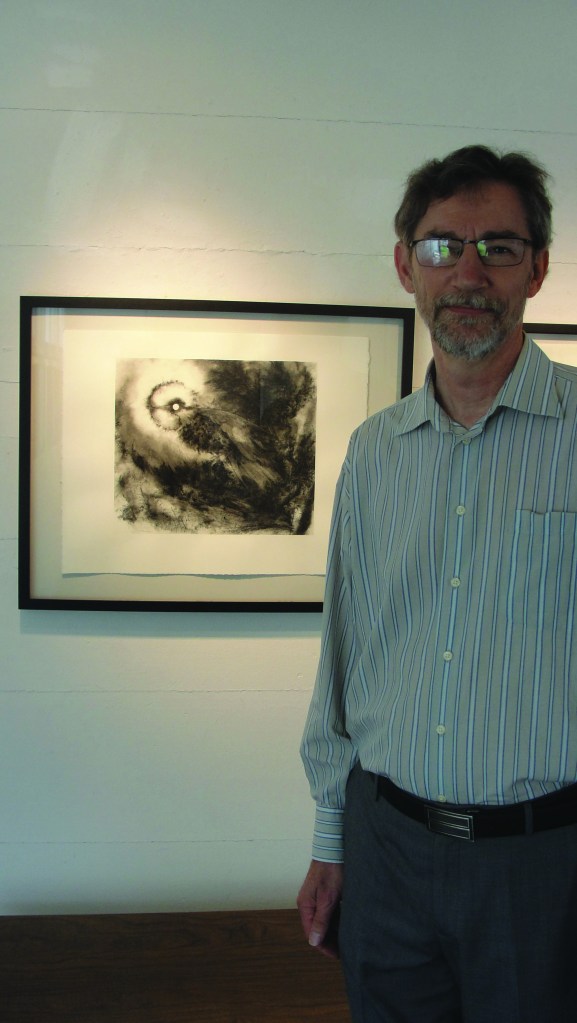‘Forest Tree Bird’ exhibit on display
Published 12:15 pm Saturday, August 22, 2015

- Artist Ken Procter stands next to his piece ‘Distelfink.’ Many of Procter’s works are part of an exhibit at the Marlor House entitled ‘Forest Tree Bird.’
Local artist Ken Procter, dean of the college of arts and sciences at Georgia College, has been selected to have his work displayed at Allied Arts.
Procter, who has been drawing all of his life, has been in higher education for about 35 years. He earned his Bachelor of Science degree in art education from Millersville University in Millersville, Penn., and his Master of Fine Arts degree from the University of North Carolina at Chapel Hill.
Trending
He took on his first role as a dean at the University of Montevallo in Montevallo, Ala., and joined Georgia College in 2008.
“It’s very much a sister school to Georgia College, though not formally,” Procter said of the University of Montevallo. “It has exactly the same history; it started as an industrial school and then became a women’s college. When Georgia College allowed men to join, so did Montevallo.”
Procter is one of the few artists who works almost exclusively in powdered charcoal, and that is the medium used in the exhibit.
“It’s distinct because it’s (charcoal) typically applied with sticks, but this is applied with brushes,” Procter said. “I’ve been using it, going back maybe 20 years, but as a serious focus, maybe 15 years.”
Procter said it was pure chance that powdered charcoal became his medium of choice. He said he is in the habit of browsing through art supply stores and picking up items that look interesting. One day he saw a jar of powdered charcoal and bought it.
“It sat on the shelf for a while, and at some point there was a drawing I did with vine charcoal. I thought if I dipped a brush into the powder I could get this sweeping arc I wanted,” Procter said. “After that, I started using it more and more. At the Marlor House, for the most part, it’s entirely powdered charcoal.”
Trending
There are two common types of charcoal: vine and compressed. Vine charcoal is usually made from a grape vine that has been burnt to a precise hardness. It contains no binding agent, and therefore remains very soft and powdery when applied. However, the charcoal vine can lose its shape, and it is not suitable for fine drawing.
Compressed charcoal is essentially powdered charcoal that has been mixed with a binding agent and then compressed to a certain hardness. The hardness of compressed charcoal can be controlled based on the ratio of the binding agent to charcoal, but it is generally harder than vine charcoal. It can be sharpened to a fine point like a pencil and used in highly detailed drawings.
Powdered charcoal is much less common as a medium, often used sparingly in artwork just to achieve a certain look. It is well suited to coloring large areas of paper, but it can be very messy to use and is applied with brushes rather than drawn directly onto the paper.
It is that reason Procter finds powdered charcoal to be his preferred medium.
“It does things that I can’t do any other way, or do as well any other way. I can make a brush stroke, and it has spontaneity as a brush stroke, a randomness,” Procter said. “It’s just powder sitting on paper so I can brush it aside or move it. I can continue to manipulate it. Vine charcoal sticks to paper, so I can’t make the changes I make with soft brushes.”
Procter said he has a variety of different brushes, two dozen of which he’ll use at any time, and several erasers as well. Each brush does a different job just as each eraser does a different kind of erasure, he said. It is with a combination of different brushes, erasers and the heaviness of the powdered charcoal applied that Procter is able to create different tones and details in each of his works.
The type of paper Procter uses also make a difference in his works, he said.
“The paper and surface also makes a difference because each interacts differently,” Procter said. “All the drawings in that show are on arches hot press, which is a very smooth surface. I have used other (paper types), but the smooth paper has less resistance to my techniques, or I should say it takes my techniques well. I can certainly feel the difference with different papers.”
Once he is finished with a piece, he has a “trade secret” way of fixing the charcoal in place.
“When a drawing is done, you have to use a fixative to cement it in place,” Procter said. “It’s brushed on, and the key, which is actually a very old process that’s been forgotten, is to put it on through the backside of the paper so as not to disturb the drawing.”
Each of the 35 works on display at the Marlor House is based on the exhibit’s title, “Forest Tree Bird.” The drawings represent a collection of about 10 years of Procter’s work, and he said if a person looks closely, he or she can see the transition from his earlier works to his more current pieces, some of which were only completed earlier this year.
While the trees are inspired from the long-leaf pines common in the south, Procter said each of the landscapes is a combination of his memory of places and his imagination of how they looked.
“This is nature of a more expressive, symbolic take,” he said.
Procter’s work will be on display at the John Marlor Arts Center, 201 N. Wayne St., until Sept. 11. Gallery hours are 9 a.m. to 4:30 p.m. Monday through Friday or by appointment. As with every exhibit on display at Allied Arts, any of Procter’s pieces can be bought, and prices range from $425 to $1,400.
For more information, call Allied Arts at 478-452-3950 or visit www.milledgevillealliedarts.com.






